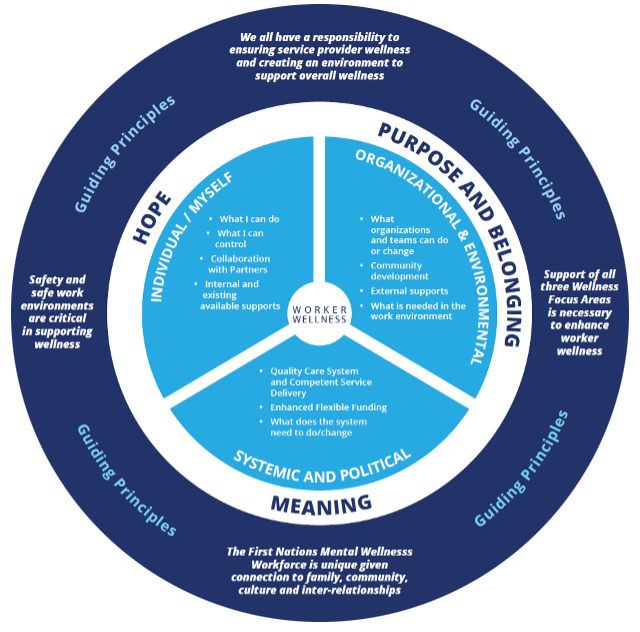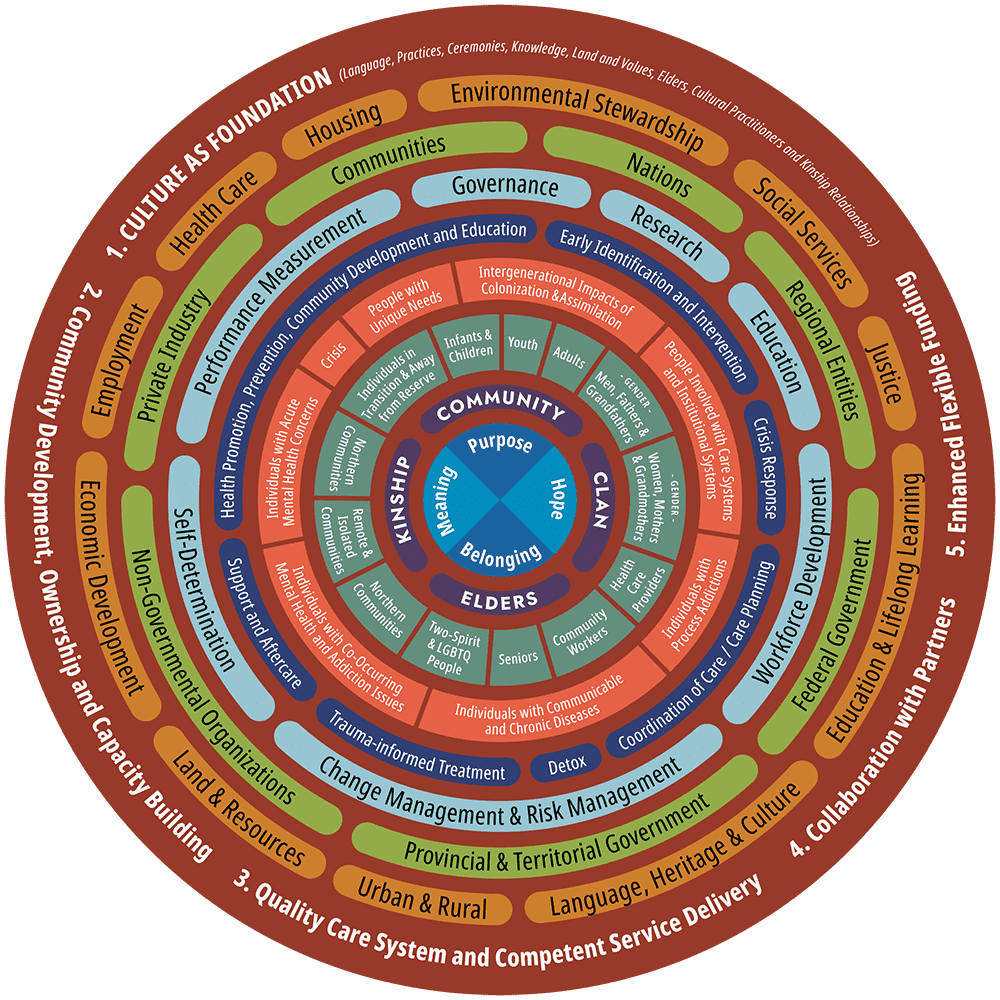Supporting the Well-being of the First Nations Mental Wellness Workforce
The Mental Wellness Teams Comprehensive Needs Assessment 2019, initiated by First Peoples Wellness Circle in collaboration with members of Mental Wellness Teams from across Turtle Island, indicated the need to develop and implement a strategy focused on supporting the well-being of the First Nations Mental Wellness Workforce (FNMWW), which includes Mental Wellness Teams, Crisis Support Teams, and other specialized wellness workforces (such as the Indian Residential School Resolution Health Support Program).
Informed by the workers who comprise it, the Workforce Wellness Strategy provides pathways, strategies, and recommendations to enhance the well-being of the First Nations Mental Wellness Workforce which serves First Nations communities.
This Workforce Wellness Strategy aims to:
- Support the wellness of the workers who comprise the First Nations Mental Wellness Workforce who serve First Nation communities and their members,
- Be reflective of those workers and the current realities they work in; and,
- Contain strategies that can be implemented in meaningful ways
Workforce Wellness Strategy (WWS) introduction video:
For additional information, watch the Information Session video below for an overview of the Workforce Wellness Strategy:
Use the buttons below to access the Workforce Wellness Strategy (WWS) and accompanying information sheets:
Workforce Wellness Strategy Framework
The Workforce Wellness Strategy Framework is grounded in the guiding principles of relationships, safety, and collective responsibility and accountability. These guiding principles can be seen in the dark blue outer circle of the framework:
- We all have a responsibility to ensure worker wellness and create an environment to support overall wellness;
- The First Nations Mental Wellness Workforce is unique given the connection to family, community, culture, and inter-relationships;
- Safety and safe work environments are critical in supporting wellness; and
- Support of all three Wellness Focus Areas is necessary to enhance worker wellness, which are:
- Individual
- Organizational and Environmental
- Systemic and Political

Each of the three Wellness Focus Areas, represented in the light blue areas of the visual, are unpacked further with themes, descriptions, and specific strategies. The strategies listed are recommendations for supporting wellness at all levels. They are not listed in order of importance, do not need to be implemented in a specific order, and do not represent an exhaustive list. The strategies listed in each theme aim to support the wellness of the FNMWW and the overall implementation of the Workforce Wellness Strategy.
First Nations Mental Wellness Continuum Framework
The Workforce Wellness Strategy is guided by the First Nations Mental Wellness Continuum Framework (FNMWCF). The themes of hope, purpose, meaning, and belonging can be seen in the white band in the Workforce Wellness Strategy Framework. These themes are connected to the three Wellness Focus Areas that are aligned within the visual. The importance of Kinship, Elders, Clan, and Community found in the FNMWCF is woven throughout the strategy. In addition, the FNMWCF Implementation Guide is referenced throughout the strategy as a resource and tool that can support the implementation of specific themes and strategies.
To learn more about the First Nations Mental Wellness Continuum Framework (FNMWCF), access the full document, summary document, the Implementation Guide, and other learning materials, please visit https://thunderbirdpf.org/fnmwc/

Journey
First, First Peoples Wellness Circle engaged with consultants to support the work; Christine Goulais from Nipissing First Nation with Christine Goulais Consulting and Advisory Services, and Amy Lickers from Six Nations with A.L.L Consulting Services.
Next, a working group comprised of mental wellness workforce team members was established to provide culturally grounded, community-driven advice and feedback on the design, implementation, interpretation and analysis for the strategic planning process.
Then, a literature review and environmental scan of the most current publications around Mental Wellness from an Indigenous perspective (including international works) was done to inform the work and better understand wise practices.
Engaging Mental Wellness Teams and relevant partners was the most important component of this project to ensure the strategic plan and recommendations are reflective of the current environment and people who are working within it. This was done through the implementation of nation-wide focus groups and an online survey.
With the support of the working group, those that participated in the survey and focus groups, consultants, and FPWC staff, a draft strategy has been developed. Again, the focus of this strategy is to be reflective of those serving communities and the current realities and be a plan that can be implemented with meaningful actions.
If you have questions, comments, or reflections about the Workforce Wellness Strategy, please contact:
Keith Martin
Workforce Development Lead
First Peoples Wellness Circle
Keith.Martin@fpwc.ca


